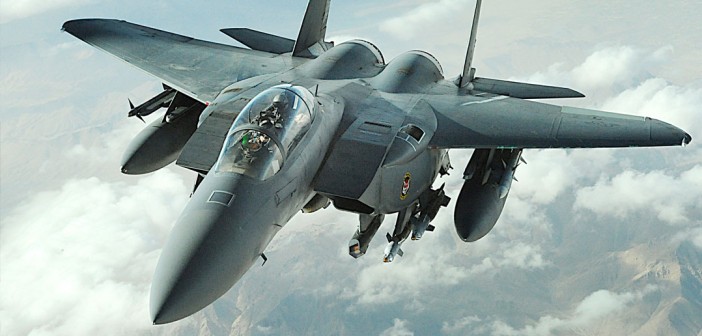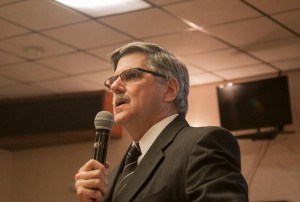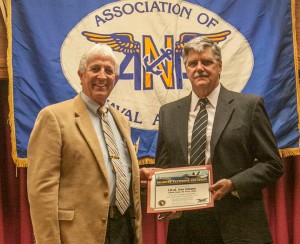Gramps was pleased to have Lt. Col. Dan Delane, Ret. USAF who spent most of his career flying the F-15 Eagle. He started in the T-38 Talon trainer then transitioned to the F-15 Eagle in which he trained for four months. He described it as “Easy to fly but hard to fly well”. He became an instructor and went to Las Vegas for the “Red Flag” training.
Red Flag is a course that takes place out of Nellis AFB four to six times a year. It is an extremely complex training and practice mission involving around one hundred twenty various aircraft at the Nevada Test and Training Range. It is involved with simulated air-to-air combat between different aircraft, both ours and some of those of our allies. Dan says the F-15 rules the sky and is the absolute best aircraft in air-to-air combat. This training involves having pilots who would have been shot down (if real ammo were used) being informed of their fate in the long debrief and then being sent out and required to parachute to the ground and be rescued! A movie was made of the operation of which many scenes were shown in the presentation.
 The F-15 was created in 1960’s to follow the F-4 Phantom, a two place fighter jet. The F-15 was created as a single pilot weapon with only one person accomplishing the many complex tasks that two were doing in the F-4. This produced a smaller and lighter aircraft with extreme engine power whose only design mission was to “Rule The Sky” as a fighter. It was designed entirely for land based operation and would not have been able to land on a carrier with its landing gear configuration. It is equipped with “Look Down, Shoot Down”. It utilizes pulse-Doppler radar that is able to recognize and track several targets simultaneously. The display is heads up (HUD) and allows the pilot to operate entirely without looking down into the cockpit for the first time. As a result, the stick had twenty-two controls on it for hands on eyes up work.
The F-15 was created in 1960’s to follow the F-4 Phantom, a two place fighter jet. The F-15 was created as a single pilot weapon with only one person accomplishing the many complex tasks that two were doing in the F-4. This produced a smaller and lighter aircraft with extreme engine power whose only design mission was to “Rule The Sky” as a fighter. It was designed entirely for land based operation and would not have been able to land on a carrier with its landing gear configuration. It is equipped with “Look Down, Shoot Down”. It utilizes pulse-Doppler radar that is able to recognize and track several targets simultaneously. The display is heads up (HUD) and allows the pilot to operate entirely without looking down into the cockpit for the first time. As a result, the stick had twenty-two controls on it for hands on eyes up work.
It is a very light ship with composite structure and light wing loading that adds to its turn capability. One fifth of the total lift comes from airflow over the fuselage. This was clearly demonstrated several years ago when an Israeli pilot suffered a hit that shot off one wing and yet managed to land the F-15 with only one wing due to the lift structure and extensive thrust to weight ratio.
It was originally built by McDonnell Douglas, later by Boeing and Mitsubishi. The wing span is 42.8 feet, the length 63 feet, the height 18.5 feet and the weight 31,700 pounds. It is a Mach 2+ (1875 mph) performer with a nominal 65,000 foot ceiling but they have been flown to 98,425 feet and then glided up to 103,000 feet after flameout. It will fly at 450 knots with only one engine operating. If the brakes are released from a standstill on the runway with engines at idle, the aircraft will accelerate to 80 mph. Its performance has set many records for speed and climb performance that still exist today. It has a large fuselage due to the need to enclose a three foot radar antenna. Engine change can be done in an hour.
They are operated by many nations around the world such as Israel, Canada, Saudi Arabia, Japan and others. Some of original airframes are still in operation and production continues to this day. None have been lost in combat.
We are grateful to Dan Delane for his service and the excellent presentation.






